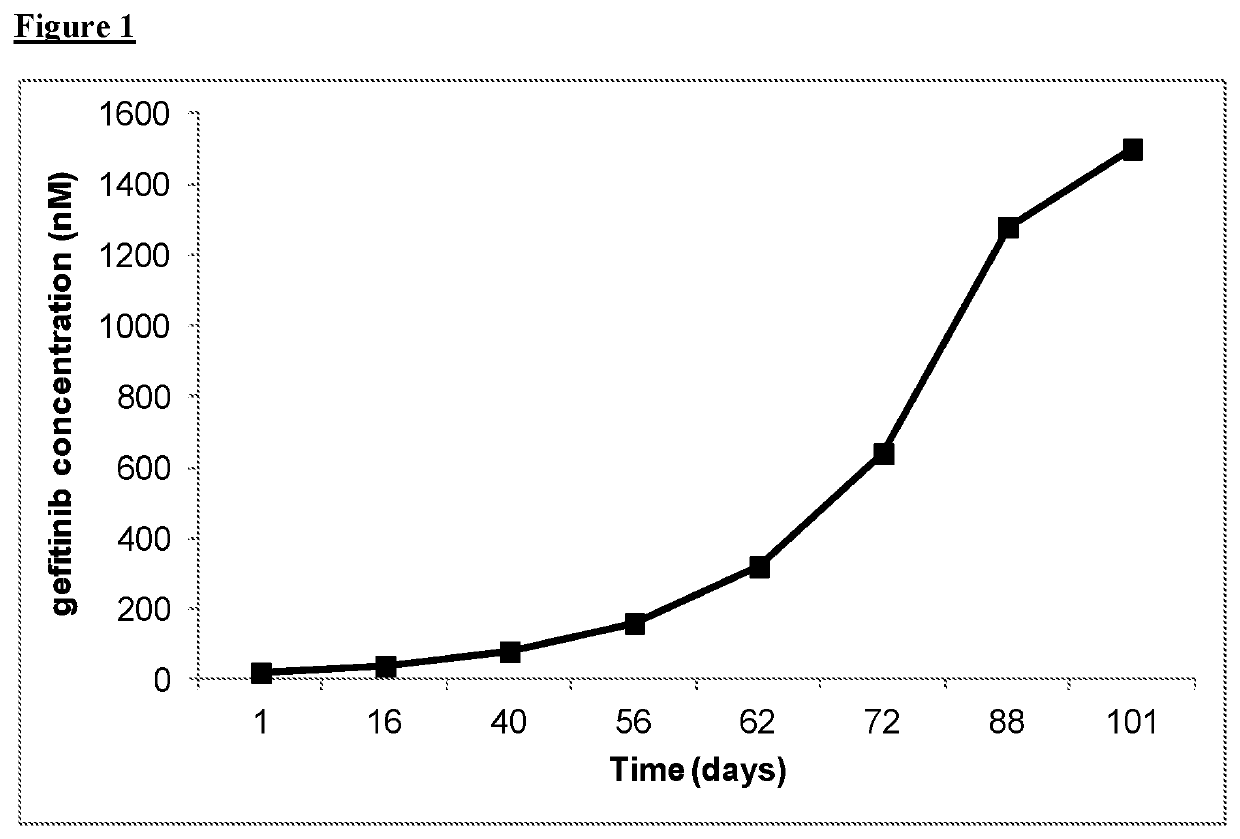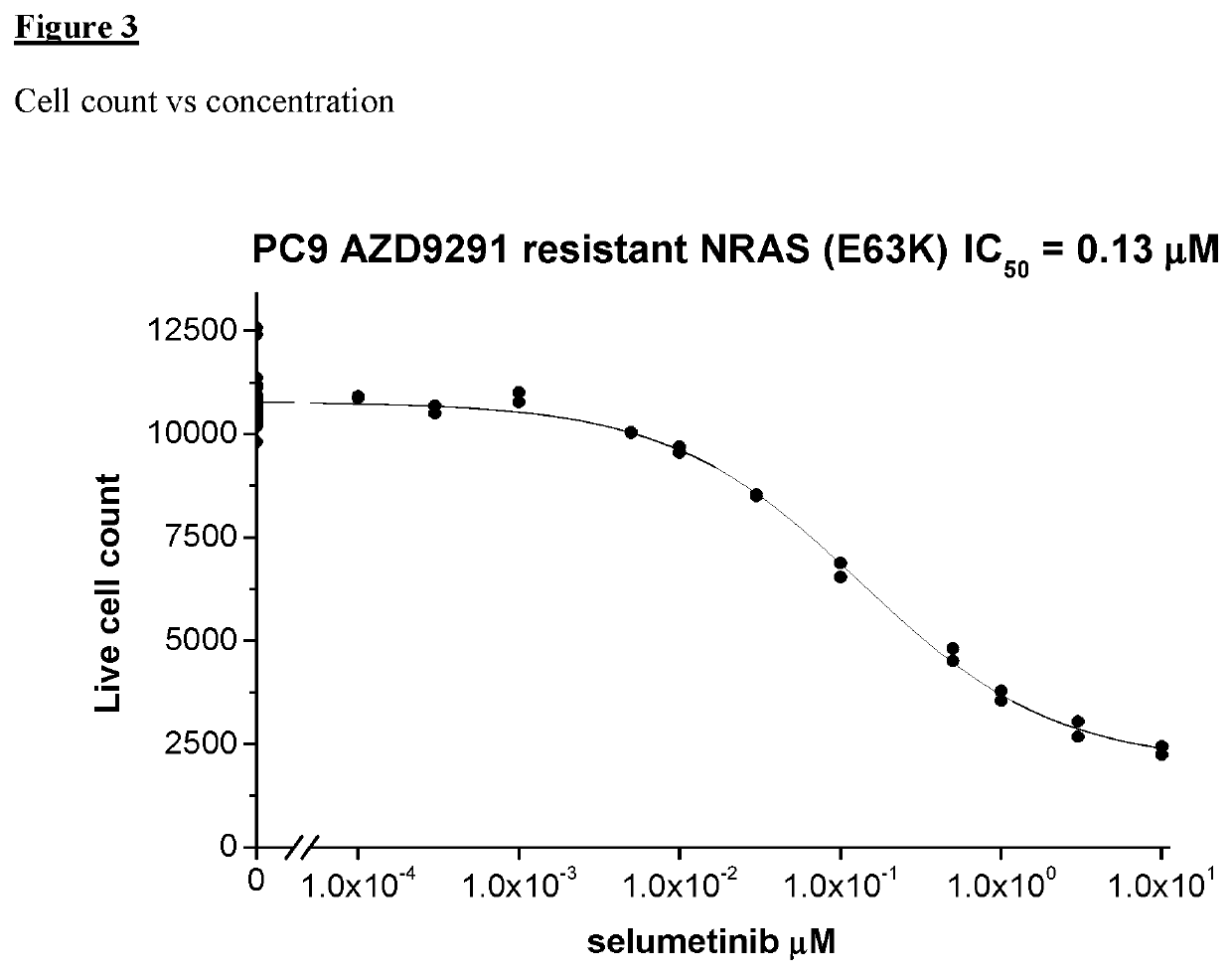Combination of EGFR Inhibitor and MEK Inhibitor for use in the treatment of NRAS mutated cancer
a technology of egfr inhibitor and mek inhibitor, which is applied in the direction of drug composition, genetic material ingredients, respiratory disorders, etc., to achieve the effect of effective first-line therapy and delay or prevent the development of resistan
- Summary
- Abstract
- Description
- Claims
- Application Information
AI Technical Summary
Benefits of technology
Problems solved by technology
Method used
Image
Examples
example 1
n of PC9 Gefitinib-Resistant Cell Population and PC9 AZD9291 Resistant Cell Population
Reagents
[0658]RPMI-1640 medium (Sigma R7509)
[0659]Dulbeccos Phosphate buffered saline (PBS) (Sigma D8537)
[0660]L-glutamine 200 mM (100×) (Gibco, Life Technologies 25030)
[0661]Foetal Calf Serum (Sigma F7524)
[0662]TrypLE Express (Gibco, Life Technologies 12605)
[0663]AZD9291 and gefitinib (in house)
Growth Media
[0664]RPMI-1640 medium
[0665]10% Foetal calf serum
[0666]2 mM L-glutamine
Cells
[0667]PC9 human NSCLC-derived cells.
[0668]All the reagents, compounds and cells are available from commercial sources.
Generation of PC9 Gefitinib, AZD9291 or Afatinib-Resistant Cell Populations Using a Dose Escalation Method
[0669]PC9 cells were seeded at 5×105 cells in multiple fresh T75 flasks in growth media and incubated at 37° C., 5% CO2. The following day the media in the flasks was removed and replaced with fresh growth media supplemented with either 20 nM gefitinib, 10 nM AZD9291 or 0.8 nM afaitnib (these concentr...
example 2
rofiling of Gefitinib, AZD9291 and Afatinib Resistant PC9 Cell Populations and Identification of NRAS Alterations
[0675]Preparation of Cell Pellets from Resistant Cells
[0676]Samples of the PC9 gefitinib resistant, PC9 AZD9291 resistant and PC9_afatinib resistant cell populations were cultured in T75 flasks until they were about 80% confluent. The cells were trypsinised as described previously and resuspended in a total volume of 10 mls of PBS. The cells were pelleted by centrifuging at 1000 rpm for 5 minutes and washed in a further 10 mL of PBS. The cells were repelleted and as much PBS removed as possible. The cell pellets were frozen at −20° C. for a maximum of 1 week prior to further processing. Similar methods were used to obtain cell pellets from other cell populations, e.g. parental PC9 cells, as necessary.
Preparation of DNA from Cells
[0677]DNA samples were prepared using the Allprep DNA / RNA / miRNA Universal kit (Qiagen) according to the manufacturer's instructions, and includin...
example 4
of Sensitivity of Resistant Cell Lines to a Combination of Selumetinib (MEK Inhibitor) and EGFR Inhibitor
[0688]The effects of a panel of canonical pathway inhibitors on cell growth and survival was measured using a cell assay using Sytox Green staining as an end point.
Reagents
[0689]RPMI-1640 medium (Sigma R7509)
[0690]Dulbecco's Phosphate buffered saline (PBS) (Sigma D8537)
[0691]L-glutamine 200 mM (100×) (Gibco, Life Technologies 25030)
[0692]Foetal Calf Serum (Sigma F7524)
[0693]TrypLE Express (Gibco, Life Technologies 12605)
[0694]AZD9291 and gefitinib (in house)
Growth Media
[0695]RPMI-1640 medium
[0696]10% Foetal calf serum
[0697]2 mM L-glutamine
[0698]Sytox Green solution—Sytox Green stain, Invitrogen S7020 5 mM stock diluted to 2 μM in TBS containing 5 mM EDTA pH 7.5
[0699]0.25% Saponin solution per well (Sigma-Aldrich Catalogue number 84510. (Saponin 2.5% stock solution prepared in TBS containing 5 mM EDTA pH 7.5 and filter sterilised)
Cell Lines Tested:
[0700]PC9 (NRAS WT)
[0701]PC9_IRGM...
PUM
| Property | Measurement | Unit |
|---|---|---|
| molecular weight | aaaaa | aaaaa |
| molecular weight | aaaaa | aaaaa |
| molecular weight | aaaaa | aaaaa |
Abstract
Description
Claims
Application Information
 Login to View More
Login to View More - R&D
- Intellectual Property
- Life Sciences
- Materials
- Tech Scout
- Unparalleled Data Quality
- Higher Quality Content
- 60% Fewer Hallucinations
Browse by: Latest US Patents, China's latest patents, Technical Efficacy Thesaurus, Application Domain, Technology Topic, Popular Technical Reports.
© 2025 PatSnap. All rights reserved.Legal|Privacy policy|Modern Slavery Act Transparency Statement|Sitemap|About US| Contact US: help@patsnap.com



